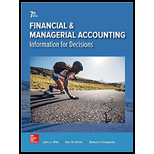
Concept explainers
Asset:
Asset may be regarded as a resource for the person or entity which holds it with a specific economic value and the benefits derived from such asset are generally divided over the lifespan of such asset .Also, they are held to reap some future benefits on account of pooling the funds at present. An asset may be in tangible or intangible form depending upon the nature of asset.
Equity:
An ownership interest in any kind of security or it may also be regarded as the difference value of the assets held and liabilities against the said assets. Also, in the financial statement of the company the funds contributed by the owners and any of the retained or ploughed back earnings (or losses) are regarded as shareholder's equity.
Liability:
A liability may be regarded as the burden or it depicts the obligatory aspect related to a transaction and that it is to be fulfilled in the near future. They mainly form part of the financial statements so that the end users may analyze the current standing of the entity in terms of its liabilities against the possession of its assets.
Net income earned or net loss incurred by the business during the year.
Want to see the full answer?
Check out a sample textbook solution
Chapter 2 Solutions
GEN COMBO FINANCIAL AND MANAGERIAL ACCOUNTING; CONNECT ACCESS CARD
- Nonearrow_forwardParker Enterprises bought a commercial property with a cash payment of 75,000 and a purchase money mortgage of $120,000. In addition, Parker paid $350 for a title insurance policy and $450 for a property survey. Parker's basis in this property is __. a. $140,000 b. $140,200 c. $195,800 d. $190,200 provide answerarrow_forwardWhat were the equivalent units for conversion costs in the Blending Department for Novemberarrow_forward
- Determine the net profit under variable costingarrow_forwardPlease explain this financial accounting problem with accurate financial standards.arrow_forwardDuring June, the production department of a process operations system completed and transferred to finished goods a total of 82,000 units of product. At the end of May, 18,000 additional units were in process in the production department and were 70% complete with respect to materials. The beginning inventory included a materials cost of $92,400 and the production department incurred a direct materials cost of $276,800 during June. Compute the direct materials cost per equivalent unit for the department using the weighted-average method.arrow_forward
- Can you explain the correct approach to solve this financial accounting question?arrow_forwardCan you help me solve this general accounting problem using the correct accounting process?arrow_forwardNovak Inc. sells one product, its waterproof camping tent. It began operations in the current year and had an ending inventory of 6,200 units. The company sold 18,500 units throughout the year. Fixed manufacturing overhead is $9 per unit, and total manufacturing cost per unit is $31.75 (including fixed manufacturing overhead costs). What is the difference in net income between absorption and variable costing? Step by step answerarrow_forward

 AccountingAccountingISBN:9781337272094Author:WARREN, Carl S., Reeve, James M., Duchac, Jonathan E.Publisher:Cengage Learning,
AccountingAccountingISBN:9781337272094Author:WARREN, Carl S., Reeve, James M., Duchac, Jonathan E.Publisher:Cengage Learning, Accounting Information SystemsAccountingISBN:9781337619202Author:Hall, James A.Publisher:Cengage Learning,
Accounting Information SystemsAccountingISBN:9781337619202Author:Hall, James A.Publisher:Cengage Learning, Horngren's Cost Accounting: A Managerial Emphasis...AccountingISBN:9780134475585Author:Srikant M. Datar, Madhav V. RajanPublisher:PEARSON
Horngren's Cost Accounting: A Managerial Emphasis...AccountingISBN:9780134475585Author:Srikant M. Datar, Madhav V. RajanPublisher:PEARSON Intermediate AccountingAccountingISBN:9781259722660Author:J. David Spiceland, Mark W. Nelson, Wayne M ThomasPublisher:McGraw-Hill Education
Intermediate AccountingAccountingISBN:9781259722660Author:J. David Spiceland, Mark W. Nelson, Wayne M ThomasPublisher:McGraw-Hill Education Financial and Managerial AccountingAccountingISBN:9781259726705Author:John J Wild, Ken W. Shaw, Barbara Chiappetta Fundamental Accounting PrinciplesPublisher:McGraw-Hill Education
Financial and Managerial AccountingAccountingISBN:9781259726705Author:John J Wild, Ken W. Shaw, Barbara Chiappetta Fundamental Accounting PrinciplesPublisher:McGraw-Hill Education





